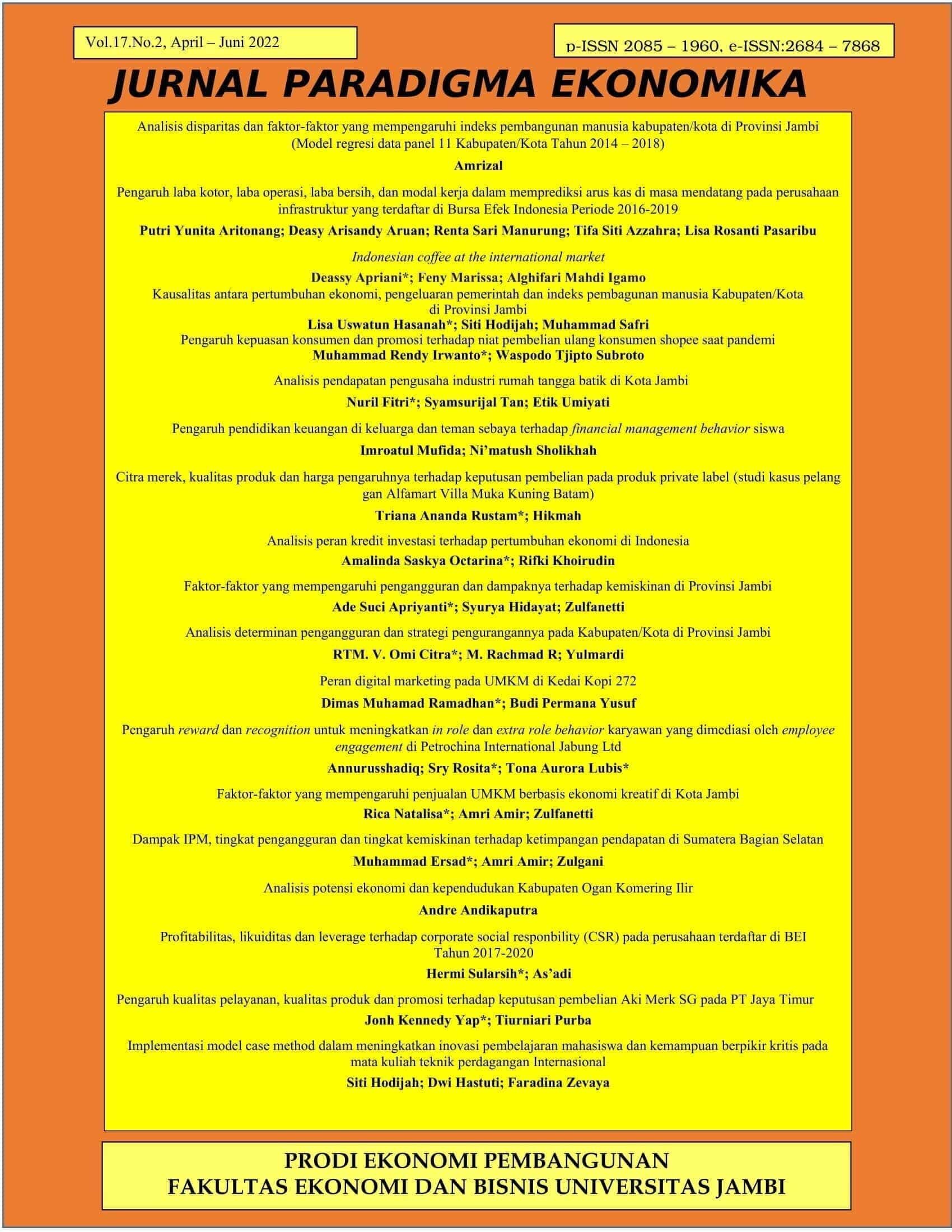Analisis struktur pengeluaran rumah tangga di Provinsi Jambi Tahun 2020
DOI:
https://doi.org/10.22437/jpe.v17i2.15696Keywords:
household expenditure structure, consumption, Government expenditureAbstract
The purpose of this study was to determine the effect of household groups on the structure of household expenditures. The data used in this study is the March 2020 Susenas raw data, namely Susenas data on household scores in 11 districts and cities of Jambi Province. The data analysis method used is descriptive method. The analytical tool used is Multiple Linear Regression (multiple regression). The results showed that in the upper urban household group, the independent variables were: household income, number of household members, age of the head of the household, education level of the head of the household, gender of the head of the household, the status of the head of the household in the main occupation, and the status of the household head. marriage of the head of the household can explain household non-food competition by 94.3 percent and together the independent variables can have an influence on household non-food expenditure. In the lower urban household group, the independent variables cannot explain expenditures other than household food because they only have an R2 value of 2.7 and together the independent variables also cannot have an effect on expenditures other than household food. As well as in the upper rural household group, the independent variable can explain household non-food competition by 65.5 percent and the independent variable can have an influence on household non-food expenditure.
Downloads
References
Astiyah S, dkk. (2004). Komposisi kepemilikan asset dan dampak kebijakan moneter terhadap kepemilikan asset: hasil survei. Buletin Ekonomi Moneter dan Perbankan: Jakarta.
Badan Ketahanan Pangan (BKP). (2017). Laporan kinerja pusat ketersediaan dan kerawanan pangan Tahun 2017. Kementerian Pertanian: Jakarta.
Badan Pengembangan dan Pembinaan Bahasa Kementerian Pendidikan dan Kebudayaan. (2017). Kamus Besar Bahasa Indonesia Edisi Kelima. Badan Pengembangan dan Pembinaan Bahasa Kementerian Pendidikan dan Kebudayaan: Jakarta.
Badan Pusat Statistik (BPS). (2019). Neraca arus dana Indonesia 2014-2018. Badan Pusat Statistik: Jakarta.
_____..(2019). SUSENAS (survei sosial ekonomi nasional) 2019 Pedoman pencacah kor. Badan Pusat Statistik: Jakarta.
_____. (2019). SUSENAS (survei sosial ekonomi nasional) 2019 Pedoman pencacah Modul Konsumsi. Badan Pusat Statistik: Jakarta.
_____. (2020). Neraca arus dana Indonsia Tahunan 2015-2019. Badan Pusat Statistik: Jakarta.
Coskun, Y, dkk. (2017). Wealth effects on household final consumption: stock and housing market channels. International Journal of Financial Studies
Hartono, J. (2003). Teori portofolio dan analisis investasi edisi kelima. BPFE: Yogyakarta.
Kusuma, B. (2008). Analisis faktor-faktor yang mempengaruhi konsumsi masyarakat di Indonesia (Tahun 1988-2005). FE Universitas Islam Indonesia: Yogyakarta.
Lipsey, dkk. (1995). Pengantar makro ekonomi. Binarupa Aksara: Jakarta.
Mangkoesoebroto. (2008). Ekonomi publik edisi 3. BPFEUGM: Yogyakarta.
Priyono, dkk. (2016). Esensi ekonomi makro. Zifatama Publishing: Surabaya.
Samuelson, P. A, dkk. (2018). Ilmu makroekonomi. Salemba Empat: Jakarta.
Sukirno, S. (2016). Mikroekonomi teori pengantar edisi ketiga. Rajawali Pers: Jakarta.
Syahatah, H. (1998). Ekonomi rumah tangga muslim. Gema Insani Press: Jakarta.
Downloads
Published
How to Cite
Issue
Section
License
Copyright (c) 2022 Nicky Rizkiansyah, Amri amir, Zulfanetti -, Zulfanetti -

This work is licensed under a Creative Commons Attribution-ShareAlike 4.0 International License.









